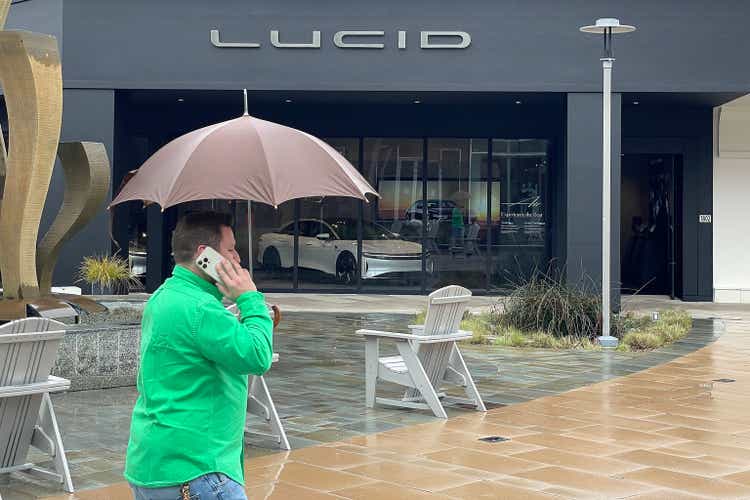Summary:
- Lucid’s production pace is disappointing.
- Inventory is piling up, as deliveries are lagging.
- The company is burning cash at a massive pace.
Justin Sullivan/Getty Images News
Article Thesis
While Lucid Group, Inc. (NASDAQ:LCID) looks strong tech-wise, the company has several major problems. Cash is being burned at a massive pace, production and sales aren’t growing as much as they should, the biggest shareholder, Saudi Arabia’s sovereign wealth fund, isn’t eager to put more money into LCID, and a potential economic downturn could be a headwind for LCID stock (and its peers). All in all, Lucid Group does not look like a compelling investment today, I believe. My previous coverage on LCID was in Feb 2023.
Lucid Group’s Most Recent Quarterly Results Were Bad
The company announced its first-quarter earnings results, which can be viewed here, in May. In short, they were pretty disastrous:
– Sales missed estimates widely, with revenue coming in around 30% below expectations.
– The company lost more money compared to what was expected.
– Production and delivery numbers disappointed.
– Cash burn remained very elevated.
– The company might run out of cash around a year from now.
Let’s get into the details. Lucid Group is a relatively young electric vehicle pure-play that is focused on the high-end market segment for now. Its model Air, which is being sold in different versions in the US and some additional markets, is strong tech-wise. The vehicle has massive hp and acceleration, can drive for a wide distance on a single charge, the 900V architecture allows for fast charging, and so on. On top of that, the vehicle is well-designed and utilizes high-end materials — which can be expected from a pricy vehicle, of course.
From a product point of view, Lucid Group thus does not look bad at all. And yet, many things seem to work far from well at the company.
During the first quarter, Lucid Group produced 2,300 vehicles. That wasn’t a very large number in absolute terms, at less than 10,000 annualized. Even worse, this number was down massively versus the previous quarter — during the fourth quarter of 2022, Lucid produced 3,500 vehicles. While a relatively young growth company isn’t necessarily expected to be profitable already, it surely is expected to grow — and that has not been the case in Q1. Instead, production volumes dropped by a hefty 34% year over year. While there have been other automobile companies with production problems in recent years as well, those were generally tied to supply chain issues such as the chip shortage during the peak of the pandemic. That is no longer an industry issue, however, which is why I believe that there is no especially good reason for Lucid to experience a big drop in production levels.
Potentially even worse, Lucid also saw its deliveries decline, even though those had already been at a sub-par level. Lucid delivered 1,930 vehicles in Q4, which was just 55% of the vehicles the company produced in the quarter. In Q1 of 2023, deliveries were even lower — the company delivered just 1,410 vehicles. That was, again, way less than the vehicles the company produced. While that is, at least to some extent, normal when production levels are rising, as it takes some time to move the increased production, deliveries should, I believe, not trail production during times when production is falling. After all, when deliveries are trailing production, that means inventories are rising. When both production and inventories are rising, assuming they do so at a similar rate, then the ratio of inventories to production remains the same, which is “normal”. But when deliveries are trailing production, and when inventory levels are thus increasing at a time when production levels are falling, then the inventory-to-production ratio is rising rapidly. This is not a good sign and further hurts LCID’s already bad cash flows. One could also argue that a combination of rising inventory levels and declining production levels might indicate a “demand problem” — potentially, Lucid isn’t able to sell all of the vehicles it produces, at least not at the price per vehicle it aims for.
While it is possible that Q1 was abnormal to some degree and that this issue will reverse in Q2, that is not guaranteed. At least for now, I’d say that the trend seen in Q1 should be watched closely by investors.
Cash Flow Problems And Questions About Capital Adequacy
Growth companies that aren’t profitable yet oftentimes burn cash during their early years. This isn’t necessarily a problem as long as the cash burn rate isn’t too high and as long as the company has sufficient liquidity to finance the cash burn until a positive cash flow level has been reached.
In Lucid’s case, that seems questionable right now, I believe. Despite the high selling price of its vehicles, Lucid sells its vehicles with a massively negative gross margin for now. This, combined with high administration, marketing, sales, and so on expenses translates into a hefty operating cash burn rate. During the most recent quarter, Lucid burned through a little more than $800 million, before accounting for investments. Once we also account for the purchase of property, plant, and equipment, Lucid burned through more than $1 billion during the first quarter — or more than $4 billion annualized. Lucid had a cash position of $3.4 billion when we include short-term and long-term investments as well. At the Q1 cash burn rate, Lucid could thus run out of cash in January 2024 or so. Management believes this will not be the case, but its own forecast isn’t much better. Sherry House, Lucid’s CFO, stated the following during the earnings call [emphasis by author]:
Lucid plans to manufacture more than 10,000 vehicles in 2023 and ended the quarter with approximately $4.1 billion total liquidity, which is expected to fund the Company at least into the second quarter of 2024.
According to its own forecasts, current liquidity will at least last until April 2024. That’s better than January, but still less than a year from now. Based on the fact that Lucid has underperformed management’s forecasts massively in some cases in the past — the company originally planned to produce 20,000 vehicles in 2022, for example, and ended up producing 7,000 — I am not entirely convinced that current projections will play out. They may very well do so, but I wouldn’t bet on it personally.
Of course, Lucid can, like every other cash-burning company, access capital markets to fund its cash burn. But with interest rates rising rapidly, accessing debt markets will likely not be easy for LCID. Doing a secondary is possible, but would have worked a lot better a year ago, with shares trading for around $20, compared to today, with shares trading for $7-$8. Lucid’s biggest investor, Saudi Arabia’s sovereign wealth fund, which owns more than 60% of the company, was rumored to make a takeover attempt in January. So far, this has not happened — at least for now, it does not look like Saudi Arabia is very interested in putting additional money in LCID. They might do so at some point, but it is not guaranteed. If LCID is forced to sell equity to other investors, that might happen at rather unfavorable terms, and since Lucid will likely not be profitable for quite some time, it could be forced to issue quite a lot of equity and/or debt to fund operations until profitability is reached.
Final Thoughts
I also want to share a small anecdote about Lucid. Last weekend, I was in a Lucid store/showing room, purely out of interest, and since I had never seen an Air in real life so far. The place was not very large but looked very nice, and the vehicle they did have in there looked great as well. It seemed like a high-quality vehicle for sure. Surprisingly, the place was completely empty — I was the only person there, apart from the salesperson. One day later, I was in a Fisker (FSR) store in the same city. While the Oceans they had on display there did not look as great as the Lucid Air (they still looked solid), the Fisker store was packed. Maybe this was a pure coincidence and maybe it is not at all representative, but to me, it suggests that Lucid may indeed have a “demand problem”. Maybe the company isn’t doing a great job at garnering attention, and that could explain why its deliveries are lagging. Peter Rawlinson, Lucid’s CEO, said something that hints at potential demand problems during the earnings call as well [see earnings release linked above; emphasis by author]:
We are on track to produce over 10,000 vehicles in 2023, with company-wide initiatives ongoing that will enable Lucid to pivot to higher volumes as market conditions allow.
Selling higher volumes is not solely tied to being able to produce more vehicles, but “market conditions” are explicitly mentioned. Maybe market conditions improve and LCID is able to sell way more vehicles in the future, e.g. when its Gravity comes out. But the potential demand issue is a risk to consider.
Overall, I don’t want to invest in LCID right here, despite the fact that Lucid’s tech still looks good. Potential demand issues, underwhelming production growth, and potential cash burn/capital adequacy problems make me want to stay on the sidelines for now.
Analyst’s Disclosure: I/we have no stock, option or similar derivative position in any of the companies mentioned, and no plans to initiate any such positions within the next 72 hours. I wrote this article myself, and it expresses my own opinions. I am not receiving compensation for it (other than from Seeking Alpha). I have no business relationship with any company whose stock is mentioned in this article.
Seeking Alpha’s Disclosure: Past performance is no guarantee of future results. No recommendation or advice is being given as to whether any investment is suitable for a particular investor. Any views or opinions expressed above may not reflect those of Seeking Alpha as a whole. Seeking Alpha is not a licensed securities dealer, broker or US investment adviser or investment bank. Our analysts are third party authors that include both professional investors and individual investors who may not be licensed or certified by any institute or regulatory body.
Is This an Income Stream Which Induces Fear?
 The primary goal of the Cash Flow Kingdom Income Portfolio is to produce an overall yield in the 7% – 10% range. We accomplish this by combining several different income streams to form an attractive, steady portfolio payout. The portfolio’s price can fluctuate, but the income stream remains consistent. Start your free two-week trial today!
The primary goal of the Cash Flow Kingdom Income Portfolio is to produce an overall yield in the 7% – 10% range. We accomplish this by combining several different income streams to form an attractive, steady portfolio payout. The portfolio’s price can fluctuate, but the income stream remains consistent. Start your free two-week trial today!
